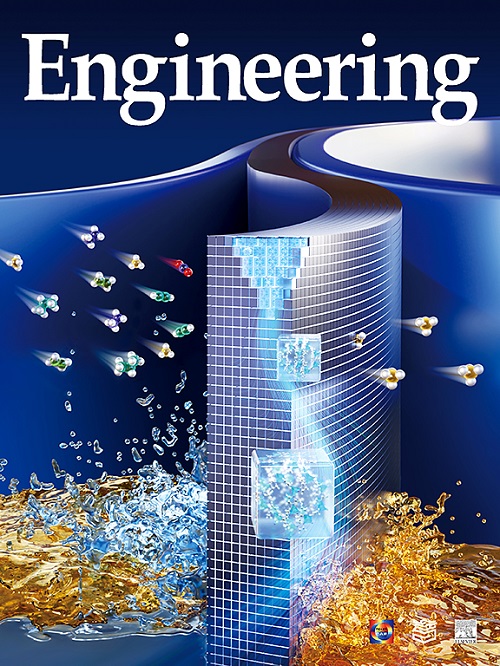微生物介导的钒酸盐还原过程中的电子转移途径和钒同位素分馏
IF 10.1
1区 工程技术
Q1 ENGINEERING, MULTIDISCIPLINARY
引用次数: 0
摘要
微生物钒酸盐(V(V))还原是环境地球化学和钒(V)解毒的关键过程,但这一过程中涉及的电子转移途径和V同位素分馏尚未完全了解。本文研究了革兰氏阳性细菌枯草芽孢杆菌(Bacillus subtilis)和革兰氏阴性细菌腐殖质thaauera humireducens (T. humireducens)对V(V)的还原机制及其伴随的V同位素分异。两株菌株均能有效降低V(V),在初始浓度为50 mg·L−1的条件下,10 d的潜伏期内V(V)去除率分别为(90.5%±1.6%)和(93.0%±1.8%)。V(V)被生物还原为不溶性钒(IV),分布在细胞内外。通过细胞色素C、烟酰胺腺嘌呤二核苷酸和谷胱甘肽的电子转移在V(V)还原中起关键作用。代谢组学分析表明,两种菌株的代谢物(醌、生物素和核黄素)富集程度不同,介导了电子转移。随着V(V)生物还原的进行,剩余溶液中的V水的同位素变重。得到的V同位素组成动力学符合瑞利分馏模型,枯草芽孢杆菌的同位素富集因子ε为(-0.54‰±0.04‰),腐殖质芽孢杆菌的同位素富集因子ε为(-0.32‰±0.03‰),差异不显著。本研究提供了V(V)生物还原过程中电子转移的分子机制,揭示了该生物还原过程中V同位素的分馏过程,有助于理解V生物地球化学和开发新的V修复策略。本文章由计算机程序翻译,如有差异,请以英文原文为准。

Electron Transfer Pathways and Vanadium Isotope Fractionation During Microbially Mediated Vanadate Reduction
Microbial vanadate (V(V)) reduction is a key process for environmental geochemistry and detoxification of vanadium (V). However, the electron transfer pathways and V isotope fractionation involved in this process are not yet fully understood. In this study, the V(V) reduction mechanisms with concomitant V isotope fractionation by the Gram-positive bacterium Bacillus subtilis (B. subtilis) and the Gram-negative bacterium Thauera humireducens (T. humireducens) were investigated. Both strains could effectively reduce V(V), removing (90.5% ± 1.6%) and (93.0% ± 1.8%) of V(V) respectively from an initial concentration of 50 mg·L−1 during a 10-day incubation period. V(V) was bioreduced to insoluble vanadium (IV), which was distributed both inside and outside the cells. Electron transfer via cytochrome C, nicotinamide adenine dinucleotide, and glutathione played critical roles in V(V) reduction. Metabolomic analysis showed that differentially enriched metabolites (quinone, biotin, and riboflavin) mediated electron transfer in both strains. The aqueous V in the remaining solution became isotopically heavier as V(V) bioreduction proceeded. The obtained V isotope composition dynamics followed a Rayleigh fractionation model, and the isotope enrichment factor (ε) was (–0.54‰ ± 0.04‰) for B. subtilis and (–0.32‰ ± 0.03‰) for T. humireducens, with an insignificant difference. This study provides molecular insights into electron transfer for V(V) bioreduction and reveals V isotope fractionation during this bioprocess, which is helpful for understanding V biogeochemistry and developing novel strategies for V remediation.
求助全文
通过发布文献求助,成功后即可免费获取论文全文。
去求助
来源期刊

Engineering
Environmental Science-Environmental Engineering
自引率
1.60%
发文量
335
审稿时长
35 days
期刊介绍:
Engineering, an international open-access journal initiated by the Chinese Academy of Engineering (CAE) in 2015, serves as a distinguished platform for disseminating cutting-edge advancements in engineering R&D, sharing major research outputs, and highlighting key achievements worldwide. The journal's objectives encompass reporting progress in engineering science, fostering discussions on hot topics, addressing areas of interest, challenges, and prospects in engineering development, while considering human and environmental well-being and ethics in engineering. It aims to inspire breakthroughs and innovations with profound economic and social significance, propelling them to advanced international standards and transforming them into a new productive force. Ultimately, this endeavor seeks to bring about positive changes globally, benefit humanity, and shape a new future.
 求助内容:
求助内容: 应助结果提醒方式:
应助结果提醒方式:


